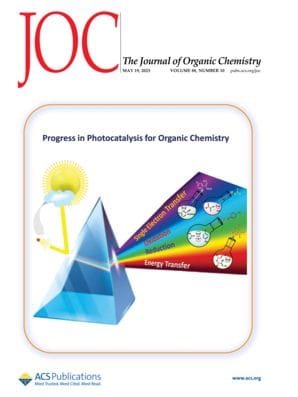This award honors the research team of an outstanding prior-year article that demonstrates creativity and impact in the broader field of organic chemistry, with a focus on early-career researchers.

The Journal of Organic Chemistry, in partnership with the ACS Division of Organic Chemistry, is proud to announce the winners of the 2024 Outstanding Publication of the Year Award:
Maryne A. J. Dubois, Juan J. Rojas, Alistair J. Sterling, Hannah C. Broderick, Milo A. Smith, Andrew J. P. White, Philip W. Miller, Chulho Choi, James J. Mousseau, Fernanda Duarte, and James A. Bull

Bottom Row, L-R: Philip W. Miller, Chulho Choi, James J. Mousseau, James A. Bull, Fernanda Duarte
This award honors the research team of an outstanding article published in the preceding year in The Journal of Organic Chemistry — either in an issue or ASAP — that demonstrates creativity and impact in the field of organic chemistry, broadly based, with a focus on early-career researchers. Fernanda Duarte, James Bull, and their colleagues are recognized this year for their article, "Visible Light Photoredox-Catalyzed Decarboxylative Alkylation of 3-Aryl-Oxetanes and Azetidines via Benzylic Tertiary Radicals and Implications of Benzylic Radical Stability," which describes a new approach in overcoming challenges in the efficient synthesis of four-membered heterocycles that are valuable structural motifs in medicinal chemistry.
The research team will be honored during an ACS Division of Organic Chemistry symposium at the ACS Fall Meeting in Denver, Colorado, in August 18-22. Learn more about Profs. Duarte and Bull, and their research below.
Prof. Fernanda Duarte is an Associate Professor in the Department of Chemistry at Oxford. She obtained her Ph.D. from the Pontificia Universidad Católica de Chile. In 2012, she joined the Department of Cell and Molecular Biology at Uppsala University as a postdoctoral fellow. In 2015, Prof. Duarte moved to the University of Oxford with a Royal Society Newton Fellowship. After a brief stint at the University of Edinburgh, she returned to Oxford in 2018. Her main research interests center on the prediction of chemical reactivity in the condensed phase, combining classical, quantum and machine-learning approaches. Prof. Duarte has received several awards, including the MGMS Frank Blaney Award (2020), OpenEye Outstanding Junior Faculty Award (2021), Harrison-Meldola Memorial Prize (2021), and Novartis Early Career Award in Chemistry (2022). She was also selected as a Finalist for Chemical Sciences in the 2024 Blavatnik Award in the UK.
Prof. James A. Bull obtained an M.Sc. degree and the Raphael prize from the University of Cambridge, then spent a year at GlaxoSmithKline. He returned to the University of Cambridge to obtain his Ph.D. under the supervision of Prof. Steven Ley. In 2007, Prof. Bull joined the group of Prof. André Charette as a postdoctoral fellow at the University of Montréal. He joined Imperial College London in 2009 as a Ramsay Memorial Research Fellow, and in 2011 was awarded an EPSRC Career Acceleration Fellowship. In January 2016, Prof. Bull was awarded a Royal Society University Research Fellowship. He received a Thieme Chemistry Journal Award in 2016, and the AstraZeneca prize for synthetic chemistry in 2021. His research targets methods for the synthesis of new chemical motifs that may be practically applied in drug discovery, to provide new design elements and extend available chemical space.
Read the Interview with the Group
What does this award mean to your group?
We were delighted to receive this award! This paper in The Journal of Organic Chemistry that led to the award is a broad collaboration between our groups at Imperial College London, Prof. Fernanda Duarte’s group at the University of Oxford, and Pfizer. We are interested in the preparation of oxetanes as motifs in medicinal chemistry, and at the same time are interested to further understand the reactivity of strained ring species. We examined synthetic, mechanistic, and structural aspects related to the reactivity of the benzylic radicals of four-membered heterocycles—and why these are different to other related structures. We are very pleased that this detailed study on the fundamental organic chemistry has been well received. This award will bring the work to the attention of an even wider readership.
How did this team come together to collaborate on this research?
We have a productive collaboration between the Bull group and Pfizer that has been running for almost 10 years on the preparation of 3,3-disubstituted oxetanes and azetidines. This particular work began with Maryne Dubois (one of the first authors and a Ph.D. student in the Bull group at the time) traveling to Pfizer labs in Groton to screen conditions for the generation of benzylic radicals on oxetanes using photoredox catalysis. Maryne established the Giese reaction with oxetane carboxylic acids and also started to question why the reaction worked well with oxetanes and azetidines but less well with other phenylacetic acid derivatives. Juan Rojas picked up the study and completed the experimental work with other coworkers. At the same time, we had been collaborating with Prof. Fernanda Duarte and Dr. Alistair Sterling at the University of Oxford on oxetane carbocations. We took the opportunity to extend this collaboration to the radical species, where Juan and Alistair (both joint first authors) took a deep dive into understanding the reaction with further mechanistic and computational investigations. Their answers to why the results were different and more productive with the four-membered heterocycles led to fundamental insight to the nature of the radical species.
What do you think is the biggest challenge currently in your area of research?
If we consider the preparation of oxetane derivatives for applications in medicinal chemistry, then there remain a number of important challenges, which reflect many of the challenges in synthetic chemistry as a whole. How can we introduce these valuable motifs in a divergent manner for discovery chemistry? How can oxetanes be installed at a late-stage for the modulation of molecular properties? And then, how can these derivatives be scaled to produce bulk compounds if compounds containing oxetanes are taken forward. These continue to be challenges across the field. We are fortunate that with these four-membered rings there are plenty of open questions to their preparation and reactions, and interesting organic chemistry to be uncovered.

Visible Light Photoredox-Catalyzed Decarboxylative Alkylation of 3-Aryl-Oxetanes and Azetidines via Benzylic Tertiary Radicals and Implications of Benzylic Radical Stability

